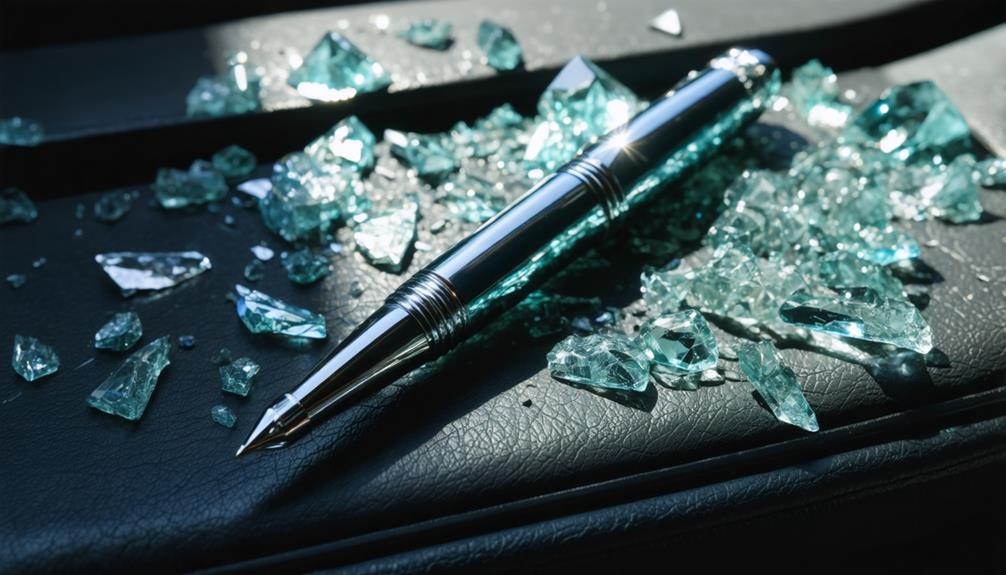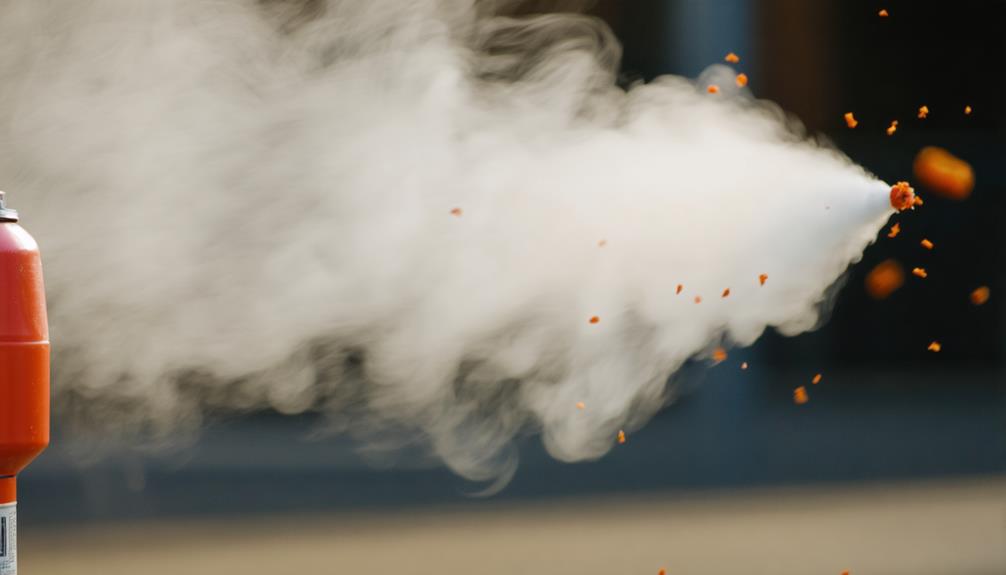
Brainstorm Security Shop

For Orders Over $199

On Any Of Our Products

Details On Refund Page
When you think about pepper spray, you might wonder how such a small canister can have such a powerful effect. It’s primarily made up of oleoresin capsicum, which contains capsaicin—the active ingredient that causes irritation. Upon contact, pepper sprays targets the eyes, nose, and throat, leading to immediate and incapacitating discomfort. But what exactly happens in the body when it’s used, and are there different types to consider? Understanding these aspects could significantly enhance your knowledge of self-defense options.
Pepper spray, often called OC spray (short for oleoresin capsicum), is primarily made from the extract of hot peppers. This powerful self-defense tool harnesses the heat from these peppers, thanks to its active ingredient, capsaicin. The concentration of capsaicin varies among different brands and formulations, typically ranging from 1% to 3%. This concentration plays a crucial role in determining how effective the spray will be against a potential threat.
In addition to capsaicin, pepper spray contains other components that enhance its effectiveness. These may include chemical irritants, which amplify the spray’s ability to cause temporary blindness, coughing, and difficulty breathing in an assailant.
The combination of capsaicin and these irritants creates a potent deterrent, allowing you to escape dangerous situations.
When choosing pepper spray, it’s essential to consider both the capsaicin concentration and the presence of other chemical irritants. Knowing these factors can help you select a product that best fits your needs, ensuring you’re adequately prepared to protect yourself if necessary.
Utilizing the intense heat from capsaicin, pepper spray works by irritating the mucous membranes in the eyes, nose, and throat of an assailant. This irritation is primarily due to the irritant properties of the active ingredient, which disrupts normal functioning and causes immediate discomfort. When you spray it, the concentrated particles make contact with the attacker, triggering a painful burning sensation.
This rapid reaction is what makes pepper spray an effective tool for self-defense applications. The sudden onset of irritation can incapacitate an aggressor temporarily, giving you precious moments to escape or seek help.
The spray creates an intense burning feeling in the eyes, often leading to involuntary tearing, redness, and even temporary blindness.
Moreover, the irritant properties extend to the respiratory system, causing coughing and choking, which can disorient the attacker. This is why pepper spray is favored in self-defense situations: it’s simple to use, non-lethal, and highly effective at creating an opportunity for you to get away safely. Understanding how it works can empower you to use it effectively if the need arises.
The immediate effects of pepper spray on the human body can be intense and overwhelming. When you’re exposed, you may experience a sharp burning sensation in your eyes, leading to involuntary tearing and temporary blindness. This happens because the active ingredient, capsaicin, irritates your mucous membranes.
You might also feel respiratory irritation; as you breathe in, the spray can cause coughing, wheezing, and difficulty breathing. This reaction can be especially dangerous for individuals with pre-existing respiratory issues.
Your skin isn’t spared, either. Upon contact, you may notice skin inflammation, causing redness, swelling, and a severe burning sensation. The discomfort can last for varying amounts of time, depending on your skin type and the concentration of the spray.
While these effects can be alarming, they’re typically temporary. Most people recover within 15 to 30 minutes, but some symptoms can linger longer. It’s crucial to seek fresh air and rinse your eyes and skin with cool water to alleviate the burning. Remember, pepper spray is a self-defense tool designed to incapacitate an attacker, but its effects on your body can be quite severe.
When it comes to self-defense, different types of pepper spray cater to various needs and preferences. Understanding these options helps you choose the right one for your situation. The main types of pepper spray differ in their chemical irritants, delivery methods, and overall effectiveness.
Here’s a quick overview of common types of pepper spray:
| Type | Chemical Irritant | Delivery Method |
|---|---|---|
| Standard Pepper Spray | Oleoresin Capsicum | Aerosol Can |
| Gel Pepper Spray | Oleoresin Capsicum | Gel Formula |
| Foam Pepper Spray | Oleoresin Capsicum | Foam Delivery |
| Stream Pepper Spray | Oleoresin Capsicum | Liquid Stream |
Standard pepper spray is commonly used for general self-defense. Gel sprays reduce wind drift, making them ideal for close encounters. Foam sprays stick to the assailant, providing a longer-lasting effect. Stream sprays can reach targets from a distance, minimizing the risk to you.
Before you decide to carry pepper spray for self-defense, it’s crucial to understand the legal considerations that come with it. Laws regarding pepper spray vary from state to state, and you need to familiarize yourself with the self-defense laws in your area. Some states allow you to carry pepper spray without a permit, while others may require one or impose specific size restrictions.
Additionally, be aware of use restrictions. You can typically use pepper spray only in situations where you’re facing an imminent threat. Using it in a non-threatening situation, or for purposes other than self-defense, could lead to legal consequences. It’s essential to know that even if you’re justified in using pepper spray, the aftermath could involve scrutiny.
Always keep in mind that even the best-intentioned self-defense actions can lead to legal complications. To stay on the right side of the law, make sure you’re informed about local regulations, carry pepper spray legally, and use it only when necessary.
Educating yourself about these legal aspects will help you make safer choices when it comes to personal protection.
Carrying pepper spray can be an effective self-defense tool, but using it safely requires some important precautions. To ensure you’re ready to use your spray effectively, focus on proper application and storage precautions.
Here’s a quick reference table to keep in mind:
| Tip | Details | Importance |
|---|---|---|
| Know Your Target | Aim for the face, particularly the eyes and mouth. | Increases effectiveness. |
| Practice Use | Familiarize yourself with the spray’s operation. | Reduces panic during an attack. |
| Store Safely | Keep it away from heat and out of reach of kids. | Prevents accidental discharge. |
Always check the expiration date and replace your pepper spray as needed. If you ever need to use it, maintain a safe distance from the attacker and be aware of the wind direction to avoid self-contamination. Remember to keep the canister upright and press the nozzle firmly for maximum spray distance. Following these safety tips can help you use your pepper spray effectively and responsibly, ensuring you’re prepared in case of an emergency.
You should avoid using pepper spray on animals for their safety and your own. Many areas have legal restrictions against it, so always consider humane alternatives and local laws before taking any action with animals.
Pepper spray typically remains effective for three to five years if stored properly. Keep it in a cool, dry place to minimize environmental impact, as improper disposal can harm ecosystems. Always follow local regulations for disposal.
You need to consider child safety when thinking about pepper spray. Many places have legal age restrictions, so it’s crucial to check local laws. It’s best to avoid giving pepper spray to children altogether.
When considering shipping pepper spray internationally, you need to be aware of shipping restrictions and legal implications in both the sending and receiving countries. It’s crucial to research regulations to avoid potential issues.
If you accidentally spray yourself, start the first aid process immediately. Rinse your eyes with cool water, wash your skin with soap, and follow the decontamination process to relieve discomfort and reduce irritation effectively.
